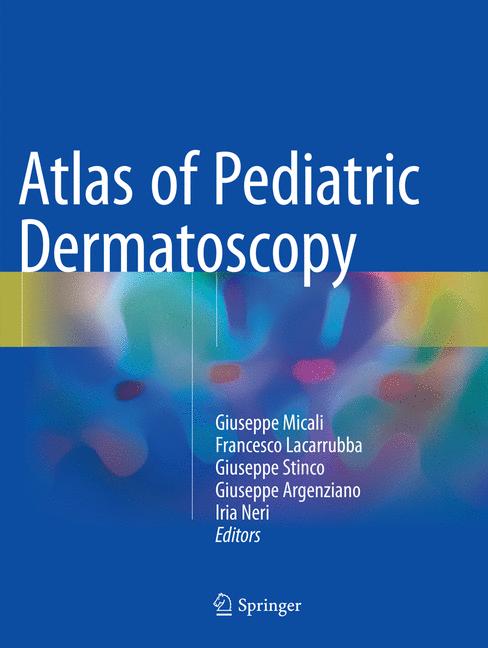This atlas, containing a wealth of clinical and dermoscopic images, describes and illustrates the applications of dermoscopy in a wide variety of skin disorders that may be encountered in the pediatric population. Key features and other salient aspects are highlighted with the aim of enabling the clinician to reach a fast and reliable diagnosis in all cases.
Dermoscopy is a non-invasive technique that allows rapid and magnified in vivo observation of the skin, with visualization of morphologic features imperceptible to the naked eye. Dermoscopy has revolutionized the approach to pigmented skin lesions, greatly improving diagnostic accuracy. Furthermore, over the past few years it has been demonstrated to be very useful in the diagnosis, follow-up, and therapeutic monitoring of a range of other skin disorders, including cutaneous/mucosal infections, ectoparasitoses, inflammatory diseases, and hair and nail abnormalities. Being non-invasive, dermoscopy is particularly suitable for use in the pediatric population, in which invasive diagnostic procedures may be problematic.
Part I Introduction 1 Instrumentation Part II Melanocytic Lesions 2 Spitz/Reed Nevus 3 Congenital Nevi 4 Childhood 5 Molluscum Contagiosum 6 Cutaneous and Anogenital Warts 7 Tinea 8 Scabies 9 Pediculosis 10 Cutaneous Leishmaniasis 11 Psoriasis 12 Lichen Planus 13 Lichen Nitidus 14 Lichen Sclerosus 15 Lichen Aureus and Majocchi’s Disease 16 Morphea 17 Pityriasis Rosea 18 Pityriasis Lichenoides 19 Darier’s Disease 20 Mastocytosis Part V Appendage Disorders 21 Alopecia Areata 22 Trichotillomania 23 Congenital Triangular Alopecia 24 Hair Shaft Disorders 25 Nail Disorders Part VI Miscellaneous Disorders 26 Pseudoxanthoma Elasticum 27 Juvenile Xanthogranuloma 28 Verrucous Epidermal Nevus 29 Sebaceous Nevus 30 Basal Cell Nevus Syndrome 31 Vascular Anomalies 32 Pyogenic Granuloma 33 Lymphatic Malformations 34 Developmental Defects
“This is a very useful book illustrating the most common skin diseases in children. … Each chapter describes in a comprehensive manner the diagnosis and etiology of the disorder followed by a series of photos (regular and with the dermatoscop). … Of high technical quality, the authors and publisher should be commended.” (Pediatric Endocrinology Reviews (PER), Vol. 16 (1), September, 2018)
Giuseppe Micali, MD, is Full Professor and Head of the Department of Dermatology, University of Catania, Italy, and Director of the Residency Program in Dermatology at the university. Dr. Micali has also been a Visiting Professor in the Departments of Dermatology at various universities, including Northwestern University, Chicago, and the University of Miami. He is an honorary member of the American Dermatological Association and a founder member of the Italian Board of Pediatric Dermatology (GIDEP), the Italian Board of Research in Dermo-Venereologic Therapy (GISTD), and the Italian Acne Board (IAB). Dr. Micali is a past Editor of the Journal of Acne and Related Disorders and has served on the editorial boards of various leading journals in the field of dermatology. He is the author of almost 200 original articles in peer-reviewed international journals and has edited seven previous international books/monographs.
Francesco Lacarrubba, MD, is an Assistant Professor in the Dermatology Clinic, University of Catania, Italy, having been a researcher in the clinic from 2008 to 2012. Dr. Lacarrubba has published widely on trichology, dermoscopy, and other non-invasive techniques and is the author of 67 original articles in international peer-reviewed journals as well as many book chapters. He has also actively participated in the most important Dermatology meetings in Italy, Europe, and the USA over the past 20 years. Dr. Lacarrubba is an editorial board member of Giornale Italiano di Dermatologia e Venereologia and International Journal of Trichology and a reviewer for various other journals, including Journal of the European Academy of Dermatology and Venereology and Journal of Dermatological Treatment.
Giuseppe Argenziano is Associate Professor and Head of the Dermatology Unit at the Second University of Naples, Italy, and Coordinator of the Skin Cancer Unit at the Research Hospital “Arcispedale
Santa Maria Nuova IRCCS” in Reggio Emilia, Italy.
His main research field is dermato-oncology, being author of numerous scientific articles and books concerning dermoscopy, a new technique improving the clinicians detection of benign and malignant skin tumors. As coordinator of a Skin Cancer Unit, he has established a successful tertiary, multidisciplinary, referral center particularly devoted to the diagnosis and management of patients with skin tumors.
Over the past 20 years he has supervised over 100 foreign students and 40 residents in Dermatology, established scientific collaborations with more than 200 colleagues from more than 30 Nations, and organized more than 50 national and international scientific activities, courses and conferences (such as the Consensus Net Meeting on Dermoscopy and the First Congress of the International Dermoscopy Society).
He is co-founder and past president of the International Dermoscopy Society; project leader for the development of a high diagnostic technology oncologic center at the Arcispedale Santa Maria Nuova IRCCS in Reggio Emilia; faculty member of the Master of Science in Dermoscopy and Preventive Dermato-oncology, and the Short Course in Dermoscopy, two e-learning courses by the Medical University of Graz and by the Cardiff University, respectively; and member of the Editorial Board of the Journal of the American Academy of Dermatology.
Professor Argenziano has authored more than 400 full scientific articles and produced landmark primary publications and books in in the field of dermoscopy. Over the past 20 years he has been invited as speaker and/or chairman in more than 500 national and international conferences in the field of dermatology. His combined publications have received a sum total of 7198 citations with an h-index value of 44 (Scopus 01/2016).
This atlas, containing a wealth of clinical and dermoscopic images, describes and illustrates the applications of dermoscopy in a wide variety of skin disorders that may be encountered in the pediatric population. Key features and other salient aspects are highlighted with the aim of enabling the clinician to reach a fast and reliable diagnosis in all cases.
Dermoscopy is a non-invasive technique that allows rapid and magnified in vivo observation of the skin, with visualization of morphologic features imperceptible to the naked eye. Dermoscopy has revolutionized the approach to pigmented skin lesions, greatly improving diagnostic accuracy. Furthermore, over the past few years it has been demonstrated to be very useful in the diagnosis, follow-up, and therapeutic monitoring of a range of other skin disorders, including cutaneous/mucosal infections, ectoparasitoses, inflammatory diseases, and hair and nail abnormalities. Being non-invasive, dermoscopy is particularly suitable for use in the pediatric population, in which invasive diagnostic procedures may be problematic.
Provides a practical approach to the dermoscopic aspects of pediatric skin disorders
Presents and discusses dermatologic conditions of the pediatric age in which dermoscopy may be useful
Includes a wealth of dermoscopic images from the authors’ collection
Guides the clinician to fast and reliable diagnosis
Provides a practical approach to the dermoscopic aspects of pediatric skin disorders
Presents and discusses dermatologic conditions of the pediatric age in which dermoscopy may be useful
Includes a wealth of dermoscopic images from the authors’ collection
Guides the clinician to fast and reliable diagnosis





